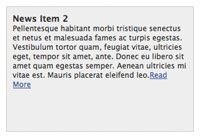Reacting to events with JavaScript is the foundation of a dynamic experiences on the web. Whether it’s a click event or another typical action, responding to that action is important. We started with assigning events to specific elements, then moved to event delegation for efficiency, but did you know you can identify elements by position on the page? Let’s look at document.elementFromPoint and document.elementsFromPoint.
The document.elementFromPoint method accepts x and y parameters to identify the top-most element at a point:
const element = document.elementFromPoint(100, 100); //
If you want to know the entire element stack, you can use document.elementsFromPoint:
const elements = document.elementFromPoint(100, 100); // [, , ]
The elementFromPoint and elementsFromPoint are really helpful for experiences where developers don’t want to assign individual events. Games and entertainment sites could benefit from these functions. How would you use them?

Dynamic Waveform Visualizations with wavesurfer.js
Waveform images are an awesome addition to boring audio widgets. They can be functional as well as aesthetically pleasing, allowing users to navigate audio visually. I recently found wavesurfer.js, an amazing waveform image utility that uses to Web Audio API to create super customizable…

Source link


